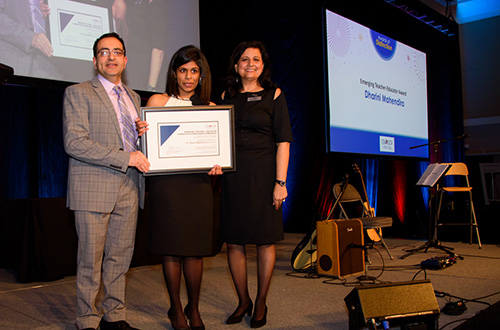Summer 2020 (Volume 30, Number 2)
The CRA's 2020 Emerging Teacher-
Educator: Dr. Dharini Mahendira
Download PDF

You’ve been recognized and awarded for your teaching and have inspired many residents to become rheumatologists. What was your first thought when you learned that you would receive this award?
I felt truly humbled to receive this recognition in the company of many superb educators within our rheumatology community. It is wonderful to receive an award for teaching – something that I’m passionate about. I take a lot of pride in seeing my students succeed. Teaching is a team effort, and I am lucky to work with talented and enthusiastic colleagues. Locally, my colleagues at St. Michael’s Hospital and the University of Toronto have supported my efforts and fostered collaborative multi-disciplinary learning. Additionally, I have had the privilege of working with wonderful educators from across the country.
I would like to thank the CRA for introducing the Emerging Teacher-Educator Award and recognizing educators who are earlier in their career. At times, measuring impact in medical education can be challenging. The acknowledgment provides positive feedback and encouragement!
What or who inspired you to become involved in medical education?
I have been fortunate to have many remarkable teachers throughout my training. In particular, Dr. Heather McDonald-Blumer and Dr. Louise Perlin have played significant roles in my development as a medical educator. I recall working with Heather and being thoroughly inspired by her insightful, skilled and collaborative approach to medical education, as well as her leadership. Louise Perlin has inspired me through her meticulous attention to detail and the importance she places on medical education. I am truly grateful for their invaluable support and guidance.
What do you believe are the qualities of a good educator?
The most important quality of a good educator is enthusiasm for learning. In my opinion, that passion translates to the learner and stimulates interest and discussion. Other qualities include being an effective communicator, as well as recognizing and addressing learner needs.
You are working on a number of exciting education projects, including immunology videos as part of a national immunology curriculum. You’ve also been the Co-Chair for the National Rheumatology Residents Weekend (NRRW) as well as the CRA Residents’ Precourse. Can you tell us more about these projects?
I’m very excited to be involved in these projects. I have been working with a talented team at the University of Toronto to develop a series of graphic videos illustrating basic immunology concepts. The aim is to consolidate basic principles of disease pathophysiology and treatment in rheumatology. The video series includes topics such as innate and adaptive immunity, disease-modifying anti-rheumatic drugs (DMARDs) and biologics, as well as pregnancy. Our team is hoping to share this video library with our rheumatology trainees and educators across the country in the near future.
It has been a privilege to co-chair both the National Rheumatology Residents’ Weekend and the Residents Pre-Course – two valuable educational initiatives supported by the CRA. Our organizing committees have worked to incorporate engaging topics as well as talented speakers. Both events were successfully held earlier this year and continue to be an excellent networking opportunity for our rheumatology trainees.
Where do you see the future of medical education moving?
Adapting to the challenges of delivering quality medical education in the era of COVID-19 was certainly eye-opening. The experience has highlighted the role of digital platforms, and how best to optimize its use for teaching. However, in my opinion, nothing can replace in-person teaching – particularlyfor physical examination!
As a respected teacher-educator, what would your advice be to a prospective rheumatologist?
I whole-heartedly recommend that students obtain as much hands-on learning as possible with their supervisors. The art and nuances of rheumatology are something best learned in person. Additionally, I would encourage prospective rheumatologists to explore an interest in medical education with involvement in teaching and educational committees – both local and national. I have grown as a result of accepting opportunities that were outside of my comfort zone – and have been inspired by talented colleagues from across the country as a result.
If you weren’t pursuing rheumatology as a career, what would you be doing?
I was actually set on a career in obstetrics when I began medical school, but fell in love with internal medicine and rheumatology. However, leading the Rheumatic Diseases and Pregnancy Clinic at St. Michael’s Hospital allows me to combine my passion for rheumatology and maternal-fetal medicine.
If you had an extra hour in the day, how would you spend it?
Getting to my spin class on time!
If you could eat one food for the rest of your life, what would it be?
This would be a tie between my childhood favourites – British chocolate and biscuits. Hence the need for spinning!

Dr. Mahendira receiving her award from CRA President Dr. Vandana Ahluwalia and
Dr. Raheem Kherani.
Dharini Mahendira, MD, FRCPC, MScCH
Division of Rheumatology,
St. Michael’s Hospital
Assistant Professor, University of Toronto
Toronto, Ontario
|
